I don’t often think of rangefinder lenses as being high spec. Being for manual cameras and requiring no electronic communication with the camera to work properly, they are by most standards inherently low spec. All things are relative though, and when compared to some other RF lenses the Thypoch 50mm f/1.4 Simera definitely feels like a high spec lens. It’s very impressive optically too!
I have a lot of 50mm rangefinder lenses. I’ve owned a lot more too. I own and have owned lenses from mainstream brands such as Nikon, Canon, Leica etc. and less well known brands such as Topcon. I even quite proudly own a lens that to date only 10 have been made – though that’s alongside lenses that have been very much mass produced. Some have lots of character, some are more objectively good. Some are fast and with that can be quite big, some are compact and slow. Some are shelf queens, and some – such as the ZM Sonnar – get used really quite often. I’ve reviewed a lot of these lenses too. I’ve even reviewed another Thypoch 50mm – the Eureka, which I was very impressed with. My point is, I’m very familiar with 50mm lenses for rangefinder cameras. I’ve all but entirely exhausted any desire to seek out any more of the things, and I certainly have within my collection a 50mm for every occasion. Despite this, the Thypoch 50mm f/1.4 Simera did and does intrigue me, and could very well find a comfortable home in my cabinet.
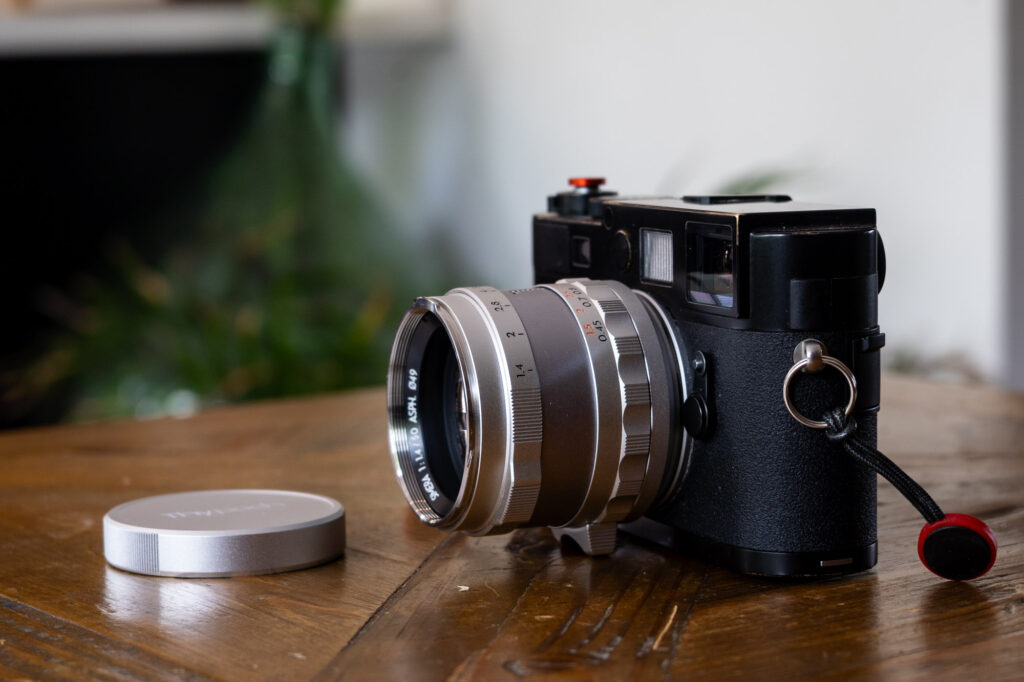
It’s actually the 3rd in this series from Thypoch. The first and second being the 28mm and 35mm versions – both of which Vincent reviewed. He liked them, and was impressed by them, but reading his reviews I was left feeling that wasn’t entirely convinced by everything they have to offer. I think just found them a little bit fussy. It’s the fussiness, or high specification as I’m calling it, that intrigued me when reading his reviews and indeed what made me say yes when Thypoch got in touch to ask if I would like to try one for review.
Build and Mechanics
The Thypoch 50mm 1.4 Simera is as I have said, highly specified. To be clearer, what I mean by this is that both optically and mechanically it appears to have had a lot thrown at it. I will come back to the optics in a minute. First there’s a lot to talk about the mechanics.
First the obvious stuff. The whole lens is metal – as you would expect from an RF lens. It feels nicely made too – though it’s not that heavy for its size. But that’s not to say it doesn’t feel like a solid bit of kit. Unlike some of the cheaper lenses that come out of China, the Thypoch 50mm 1.4 Simera certainly feels quite premium and precise. Of course, short of taking the lens apart, it would be very hard to say how well it is made internally, but externally it doesn’t readily give away any shortcomings. For all that though it is quite a large lens, especially compared to my fast 50 of choice – the ZM Sonnar.
The Thypoch 50mm 1.4 Simera comes with two caps and a hood. One of the caps pushes onto the front of the lens without the hood on, the second with the hood on. The hood and the big square cap obviously work to make the lens even bigger than it is with the standard hood. I don’t tend to use hoods much and don’t tend to carry lenses with caps for the most part, so more often than not left all three of the accessories at home when testing the lens. Two caps and a big hood felt like a lot of clutter to have associated with a lens, but I suppose most people probably don’t already have as much photography clutter already kicking around in the way that I do. All three ended up in a basket with other such stuff whilst I had the lens on loan – I even somehow forgot to return one of the caps and so still have it cluttering my basket of similarly unused paraphernalia (not least the clutter that came with the Eureka).
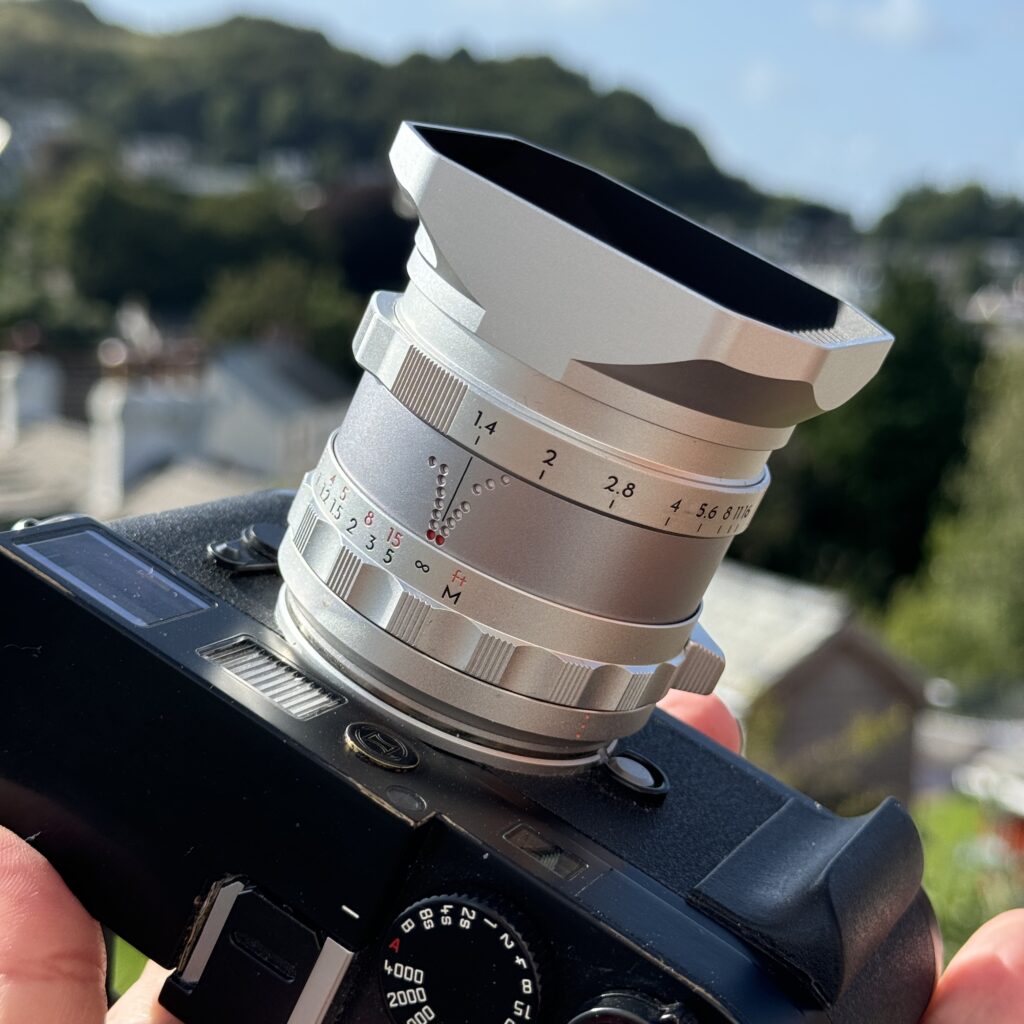
Focusing the lens feels smooth, without anything of the feel of metal on metal that sometimes gets in the way of cheaper lenses feeling like a more quality product. Smooth that is until you reach the click stop at 0.7m – this is a feature I really love. I have plenty of rangefinder lenses that focus below 0.7m, but few have this feature. It just helps know when you’re in the area of focus where the rangefinder doesn’t confirm focus. Below the click stop, the lens focuses down to 0.45m – of course when mounted on a film or earlier generation of digital rangefinder it’s quite difficult to achieve perfect focus, but when mounted on one with a digital viewfinder or oven just when adapter to a mirrorless camera, this definitely makes for a more versatile lens.
The aperture control is smooth too. It even has a little switch for selecting either clicked or un-clicked stops – a feature that video folks sometimes prefer. One of the features the Vincent points out as not liking is the uneven spacing between stops. Personally, this doesn’t bother me at all. I wonder if I might have noted it as a negative on a lens in the past – I can’t remember – but certainly these days I don’t really find myself noticing any issue with it in real life shooting.
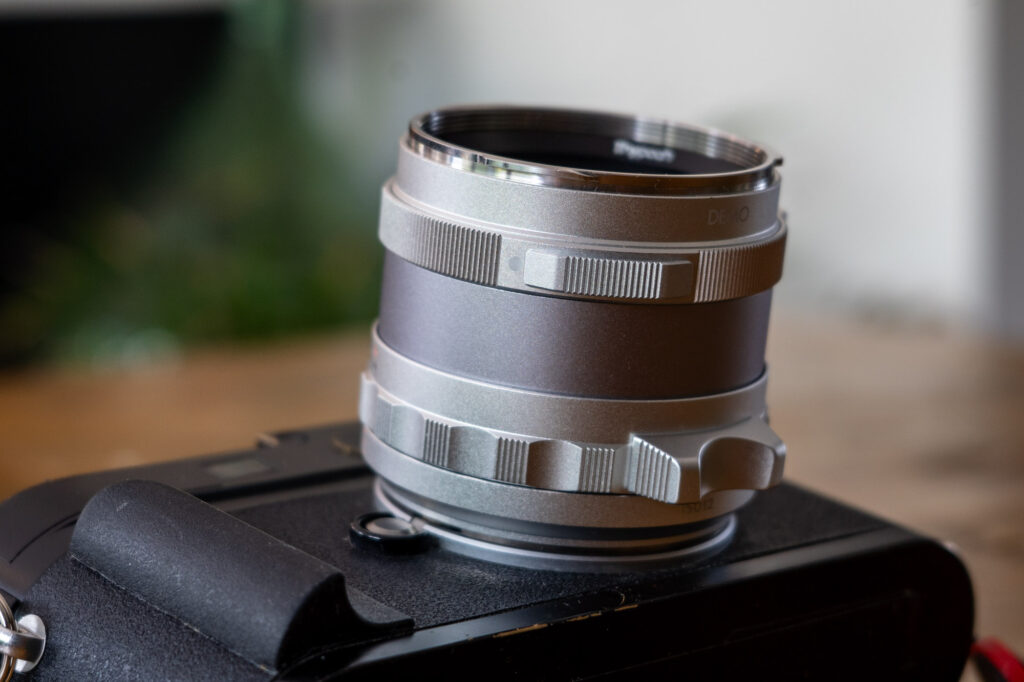
Changing the aperture on the lens also makes a series of little dots appear and disappear on the body of the lens. These dots indicate the depth of field markings for the chosen aperture. These might seem unusual to some, but one the first manual focus lenses I ever interacted with had the same feature. I remember playing with my Nan’s B8 Bollex Kern Switar 12.5mm lens when I was a child – it’s a camera I still have now and get a nostalgia kick from playing with it to this day. Some of this favour transfers to the Thypoch 50mm 1.4 Simera – I just can’t help myself enjoying those little dots on both an aesthetic and engineering level and for how they indicate the depth of field. They just make sense to read to me. Though, I should add that thanks to the fairly short focus throw the dots are only really much use when the lens is stopped down a good few stops. At wider apertures, the difference in the spacing between the dots is pretty meaningless too.
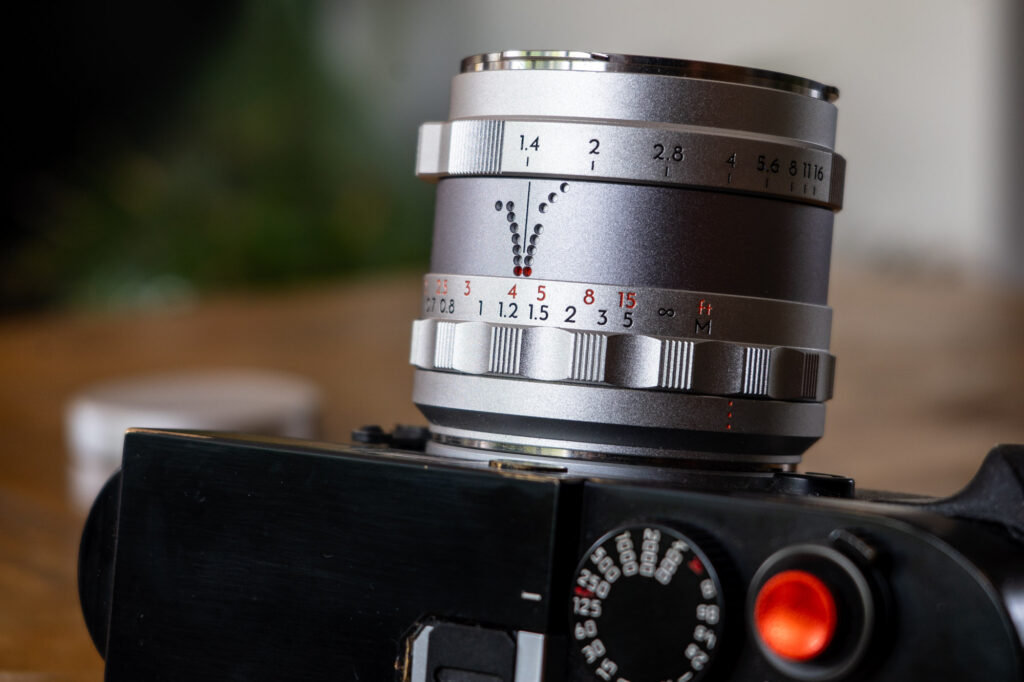
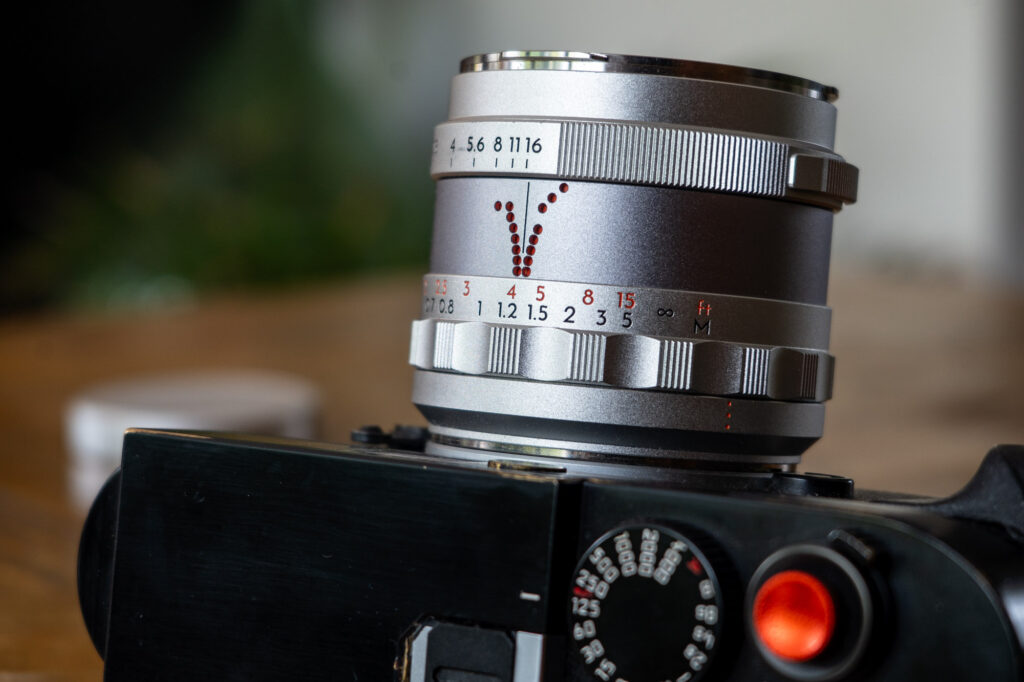
Opto-mechanics
This is the point that I usually just get to how the lens takes photos. Unusually for me, I’m going to talk a little bit about the actual glass. You can read all the guff about ED and HRI elements on their website. I’m no optics expert, but I’m sure their claims go somewhere to reaching the truth. As I will get to, this lens is certainly impressive when it comes to the quality of the images it is capable of.
The opto-mechanical design feature I did want to flag up though is the FLE design. FLE, or floating lens element lenses are much less common than usual rangefinder lenses which are more often than not unit focusing. Unit focusing lenses move all the elements together at the same time, FLE lenses have an element or element group that moves independently of the rest of the elements. The purpose of this is to ensure the highest possible quality of image rendering at all focus distances. The disadvantage of FLE lenses is that they don’t work on autofocus lens adapters since when using those, the lens is never set to the distance it’s focused at. I talk a bit more about this in my review of the Techart LM-EA9 here.
The Thypoch 50mm 1.4 Simera is also something of an internal focusing design. Or at least, the outer barrel of the lens doesn’t get larger or smaller when focusing. Instead, the optics move inside the barrel. My guess is that this is something to do with the FLE design, but it also no doubt goes some way to explain why the lens is as big as it is.
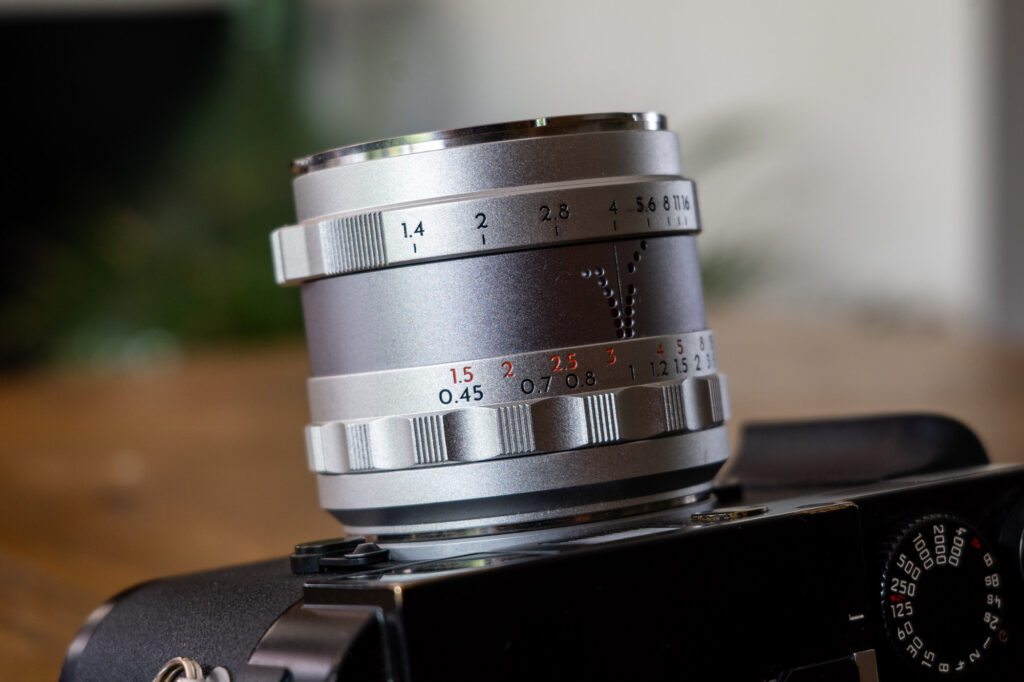
Optics
This lens was my lens of choice for a big chunk of the kids’ summer holidays. Thypoch were kind enough to loan it to me for a good few weeks, and in that time I put it through its paces in a fairly wide variety of shooting situations on both the Sony A7iii and, more frequently, the Leica M9. Just so as you’re aware, the M9 I am using is one that has had its corroded sensor glass replaced with the same BG40 glass that was used on the M8 sensor. Because of this, I have also been using a high quality IR cut filter. The resulting images from this camera are, I believe, stunning. But, objectively speaking they are quite warm-toned. I mention this just to highlight that this toning is a product of the camera and not the lens.
A very “good” lens
That out of the way, let’s talk about the optical qualities of this lens. To kick off, I should just first say that I find it more difficult to review lenses like this. This lens is good. It’s really good in fact. Optically speaking, reviewing a lens like this is almost a little boring for someone like me. When I shoot new-to-me lenses like this, I am looking for the interesting optical flaws, the character, the little something that gives the images taken with it something of a signature. In the case of the Typhoch Eureka, those character traits were subtle, but they were there.
After a few outings with the 50mm 1.4 Simera, taking the photos, uploading them onto my computer and browsing through them, my anticipation of finding something characterful to talk about passed. In fact, I stopped thinking about the optics and found myself just thinking about this lens in a similar way to how I think about my work lenses and some of my own better quality modern digital lenses. My Samyang 75mm 1.8 is another lens I feel like this about – these are lenses that I can just trust to take high quality photos of pretty much anything I point the lens at. That is to say, they are lenses that don’t present my with obvious character traits that I enjoy, or many ugly aberrations I don’t, they just remove themselves from my photography.
 I don’t tend to review lenses like this, simply because they are of a quality that surpasses a threshold that means my lens “testing” style doesn’t really work any more. I don’t do lens testing in the way Bastian from Philip Reeve does. I respect the guy a great deal, and trust his reviews and thoughts above literally every other lens reviewer who’s reviews I regularly read. But partly because folks like him do what they do, I don’t do what they do. I just like taking photos and sharing what I see. And I much prefer sharing what I see when what I see is in some way extraordinary or, more specifically unusual. Well, all I see here is a lens that’s essentially extraordinarily good. There’s nothing about it that jumps out as me as particularly characterful at all really. With that said, let me talk you through what I have found.
I don’t tend to review lenses like this, simply because they are of a quality that surpasses a threshold that means my lens “testing” style doesn’t really work any more. I don’t do lens testing in the way Bastian from Philip Reeve does. I respect the guy a great deal, and trust his reviews and thoughts above literally every other lens reviewer who’s reviews I regularly read. But partly because folks like him do what they do, I don’t do what they do. I just like taking photos and sharing what I see. And I much prefer sharing what I see when what I see is in some way extraordinary or, more specifically unusual. Well, all I see here is a lens that’s essentially extraordinarily good. There’s nothing about it that jumps out as me as particularly characterful at all really. With that said, let me talk you through what I have found.
Sharpness, contrast and pop
In normal use, the 50mm 1.4 Simera is as sharp as I could ever need a lens to be. There is a little bit of fall off into the corners wide open. This seems to be more the case on cameras with thicker sensor cover glass like the Sony, but even then corner softness isn’t particularly notable – at least not by my standards. Stopping down seems to sharpen the corners nicely and also seems to give a little bump to contrast. By the middle apertures it’s a really very fine lens that’s capable of very high quality results.
 It’s also capable of creating a moderate amount of 3d pop. It’s far from in the same class as my favourite Zeiss lenses when it comes to pop, but I’d say images have a reasonable amount of three-dimensionality to them in a way you don’t see so much in some modern mirrorless lenses as much.
It’s also capable of creating a moderate amount of 3d pop. It’s far from in the same class as my favourite Zeiss lenses when it comes to pop, but I’d say images have a reasonable amount of three-dimensionality to them in a way you don’t see so much in some modern mirrorless lenses as much.
 What might be a little surprising is that thanks, I suspect to the FLE design, it’s also very sharp at close distances. This is definitely something I’m less used to with rangefinder lenses, as most of the ones I own and shoot have much more of a glow to them when shot closer up. Not so here. Even at the minimum focusing distance, it’s sharp with little signs of any sort of the glow that I’m used to seeing.
What might be a little surprising is that thanks, I suspect to the FLE design, it’s also very sharp at close distances. This is definitely something I’m less used to with rangefinder lenses, as most of the ones I own and shoot have much more of a glow to them when shot closer up. Not so here. Even at the minimum focusing distance, it’s sharp with little signs of any sort of the glow that I’m used to seeing.

Bokeh and out of focus rendering
The result of this is there’s also little in the way of glow in the transition from in focus to out-of-focus. This seems to give fairly strong subject separation which definitely helps with the sense of 3d pop I mentioned above.
 Bokeh is also very “good”. I’ve found the general out-of-focus rendering to be very smooth and to rarely cause any sort of distraction. There’s some cat’s-eye effect toward the edge of the frame, but that’s hardly unusual. Out of focus highlights are pretty solid with little or no edging.
Bokeh is also very “good”. I’ve found the general out-of-focus rendering to be very smooth and to rarely cause any sort of distraction. There’s some cat’s-eye effect toward the edge of the frame, but that’s hardly unusual. Out of focus highlights are pretty solid with little or no edging.

The only time I found any sort of distraction in the background was shooting wide open at a distance from the subject, but even then it wasn’t too much of a problem – and it’s not like this is a particularly regular shooting situation anyway.
 In pretty much every more “normal” shooting situation I found the bokeh to be pleasing when I paid attention to it, though more often than not it disappeared into the background… as it probably should.
In pretty much every more “normal” shooting situation I found the bokeh to be pleasing when I paid attention to it, though more often than not it disappeared into the background… as it probably should.
 Even stopped down, the 50mm 1.4 Simera performs very well. It has loads of aperture blades meaning that out of focus highlights are rendered nice and circular.
Even stopped down, the 50mm 1.4 Simera performs very well. It has loads of aperture blades meaning that out of focus highlights are rendered nice and circular.
Vignetting
Again, wide open it vignettes a little in the corners, but not much really. I haven’t really spotted or felt aware of any vignetting specifically impacting my photography.
Flare
I haven’t been able to make it flare much at all. I haven’t seen any veiling flare, nor much in the way of ghosting aside from a tiny green blob in one photo, and a rogue bit of a rainbow in another with the sun right at the edge of the frame, but that was the only occasion I was able to make this happen, and was when I was specifically trying to make it happen.

Distortion
I also can’t detect any meaningful distortion – maybe a little pincushion, but I might be wrong.
Chromatic aberrations
I don’t usually talk about this sort of thing, but since I can find very little fault elsewhere, it seemed like I should point out where I have found something. High contrast edges caused some purple fringing that really jumped out at me in this photo.

If you zoom in on the background of this photo you can also see some fringing on the bokeh.

I don’t own a Summilux
And that’s all I have to say on the image quality – it really is a very high quality optic! This is exactly what Thypoch want me to say too… I know this as when I was sent the 50mm 1.4 Simera, Typoch asked me if I had a modern Leica Summilux to compare it to. As I’ve said, I make no claims to be an optics expert, but if you look at the formula of this lens compared to the Summilux, they look pretty similar. Is this lens a “copy”? I’m not sure. Is it intended to offer Summilux-level quality (whatever that means…) images? Yeah, I think it might be.
Funnily enough, it was the idea of comparing this lens to the Summilux that made me think about this lens finding a home in my cabinet. The answer to the question as to whether or not I own a modern Summilux is very much that I don’t, never have, and likely never will. I only own one lens made by Leica and that’s a collapsible 50mm Elmar that’s about 80 years old. I can simply no longer afford or justify Leica lenses, certainly not the modern ones. Moreover, having shot with a few of the things, I don’t actually personally see the value in the modern ones – if I wanted photos that are ridiculously high quality, in objective terms at least, and had thousands of pounds to spend on lenses, I’d likely be much more inclined to spend the money on something autofocus for my Sony. Probably something with GM in the nomenclature. I’m not here to tell anyone how to think or feel about their choices, but for my money the only time I feel I specifically need objective quality within my results is when I’m shooting for work. And in those circumstances, I also appreciate conveniences such as high speed autofocus.
My favourite Leica M mount 50mm lens is the Zeiss ZM Sonnar. That lens has an incredible amount of character. It’s near as fast as a Summilux being a f1.5 lens, but when it comes to objective measures of things like sharpness, it lags very far behind. It’s simply not designed to be an objectively high quality lens, it’s designed to impact the images taken with it with a look; a look that I happen to love. These are the sorts of lenses I tend to seek out as part of my hobby. I like lenses with character and would be more inclined to spend more on a lens with certain character traits that I like than I would be inclined to spend on a lens that was designed not to have said traits. As such, the idea of spending £4000+ on a new 50mm Summilux – a lens thats designed to have as few character traits as possible – just seems alien to me. Of course, some do seek that absolute best objective quality in lenses for their Leica – and you’ll never find me arguing with their reasoning; each to theirs, I say. Optical quality isn’t the only reason to buy Leica lenses either, they are also very well made and feel lovely to use etc, etc. and then there’s also the brand factor. My point being, there’s a load of reasons why people choose Leica lenses, but there’s also just as many reasons why people don’t. For many, 3rd party lenses offer something else – potentially even something more.
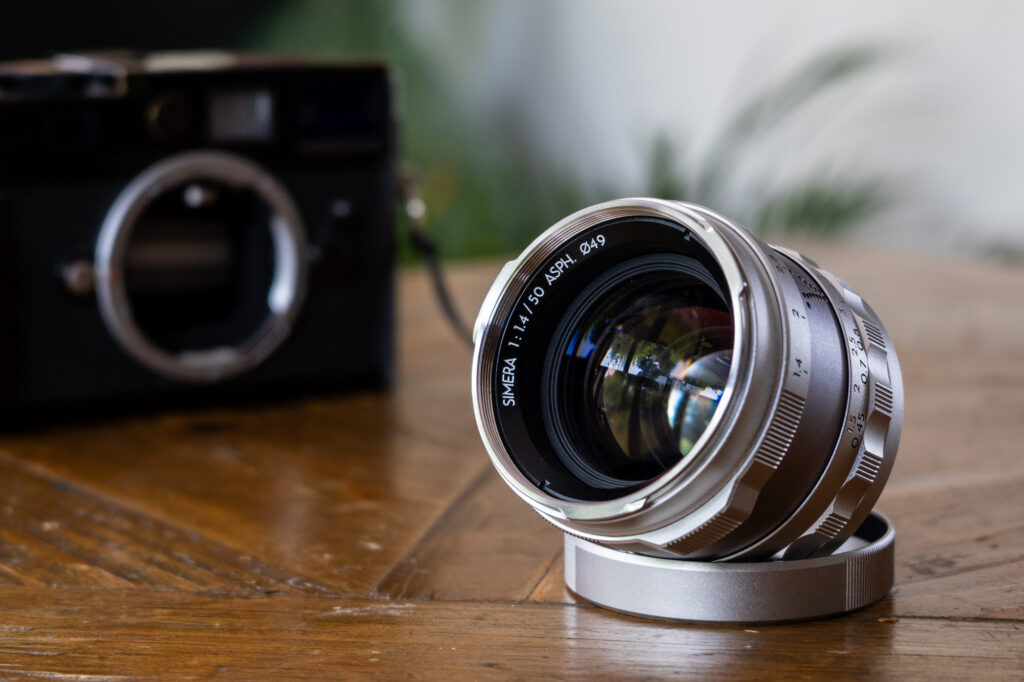
Final thoughts
In the case of the Thypoch 50mm 1.4 Simera, the lens offers mechanical features I have spoken about with Summilux-quality optics at a fraction of the price. For some, there is no way that a 3rd party lens like this could replace a Leica Summilux, but for others – people like me – it represents something of an opportunity. It represents an opportunity to have a lens option that’s right up there in optical terms with some very much more high quality lenses. A lens like this will likely never appeal to me more than something like the ZM Sonnar, but that’s just because I personally generally prefer lenses like the Sonnar that have those strong character traits. But as I found with this lens over the summer – just as I do when I use my Samyang for e.g. – I can shoot very happily with a lens that completely disappears from my photography and just produces excellent results given pretty much any shooting situation. I might not feel like I need a lens like this for my hobby, but it still represents a nice-to-have. It’s nice to have a lens that offers close focusing, and all the rest of the mechanical features. It’s nice to have a lens that offers optical qualities that make for a lens that all but disappears from the photos that are taken with it. And thanks to the price point, it’s a nice to have that feels way more accessible than the likes of the Summilux. And that’s just for someone like me. For those that are looking for the highest quality optical performance, but don’t have the budget for higher end gear, well, a lens like the Thypoch 50mm 1.4 Simera might be something of a no-brainer!
You can find more of my photos taken with this lens here
You can also read more about this lens on Thypoch’s website here
Finally, thanks to it taking me so long to get around to finishing this review, there’s now black friday deals on this lens as well as the rest of the Simera line. If you go here, you’ll find the deals, and apparently if you use the code 35mmc-TP you can get free shipping too.
Share this post:
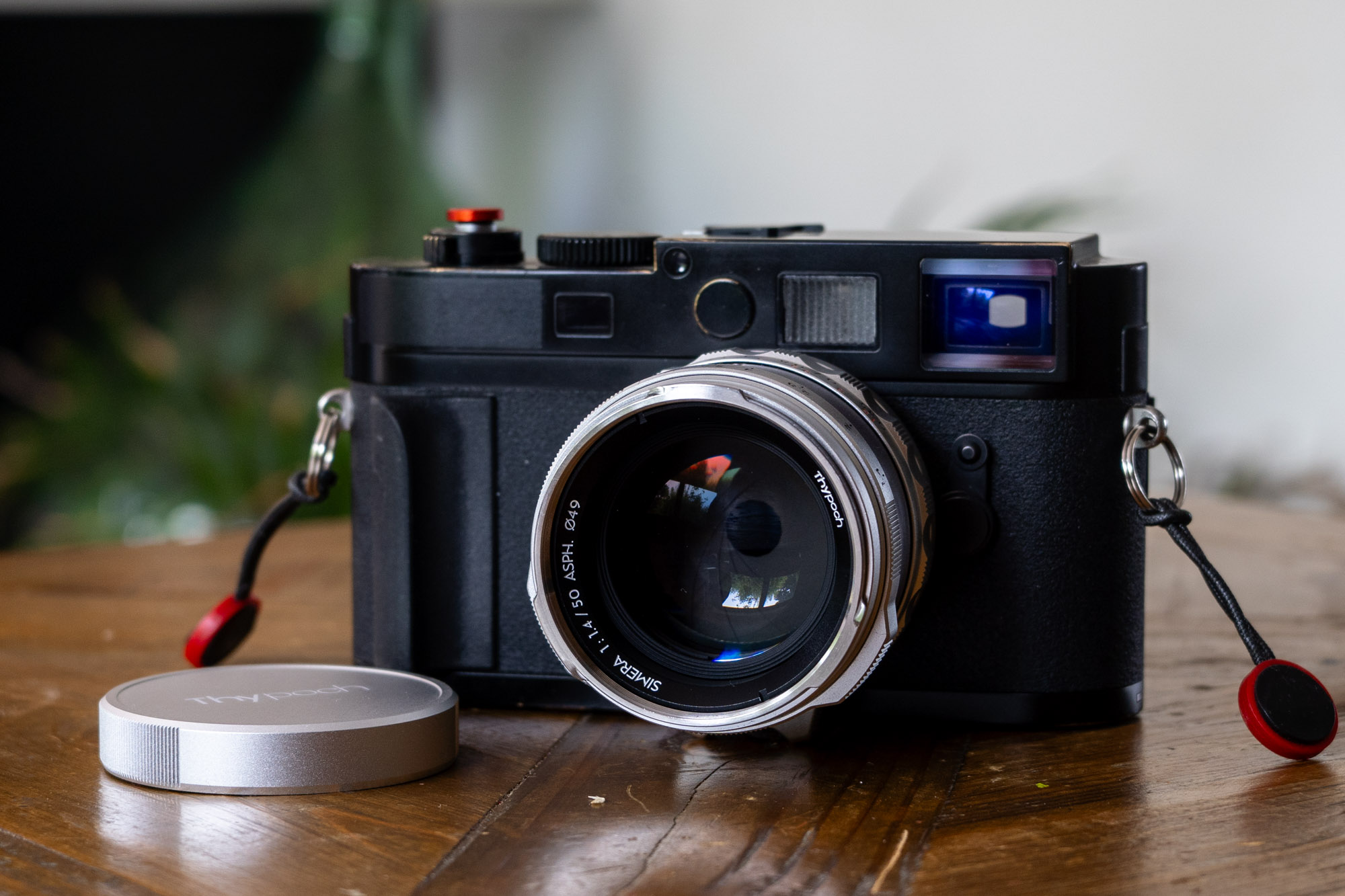

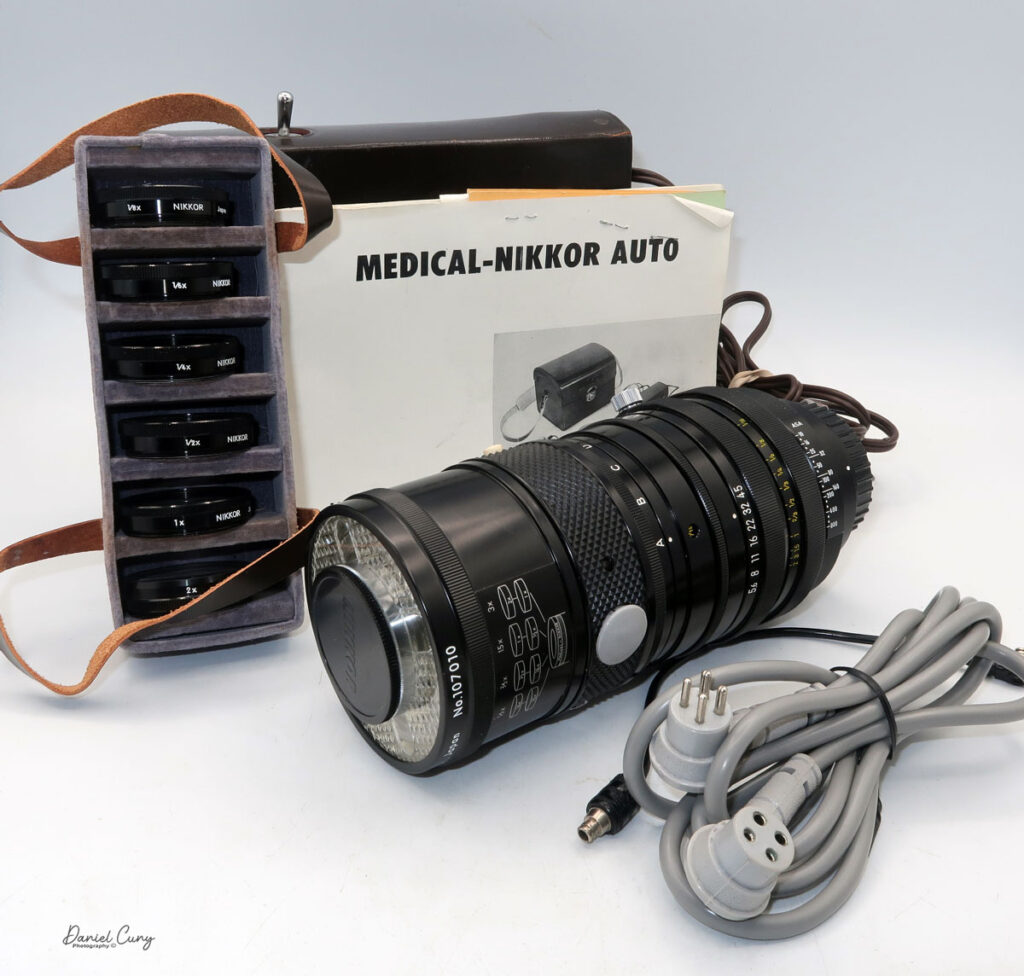

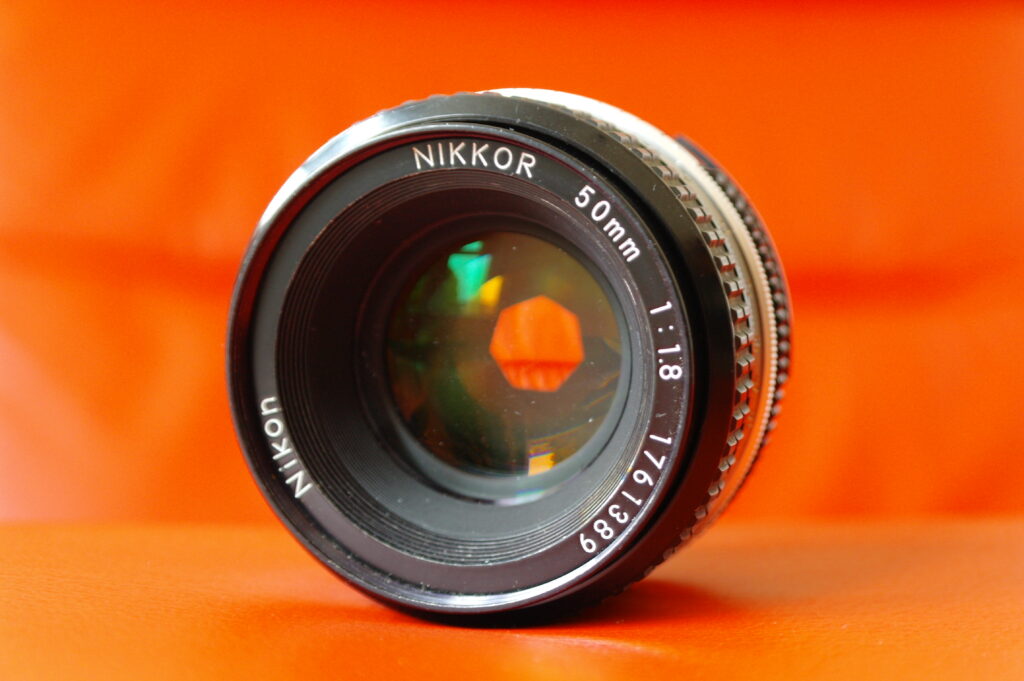




Comments
Geoff Chaplin on Thypoch 50mm 1.4 Simera review – A high spec rangefinder lens!
Comment posted: 12/11/2024
Eric on Thypoch 50mm 1.4 Simera review – A high spec rangefinder lens!
Comment posted: 13/11/2024
Michael on Thypoch 50mm 1.4 Simera review – A high spec rangefinder lens!
Comment posted: 28/12/2024